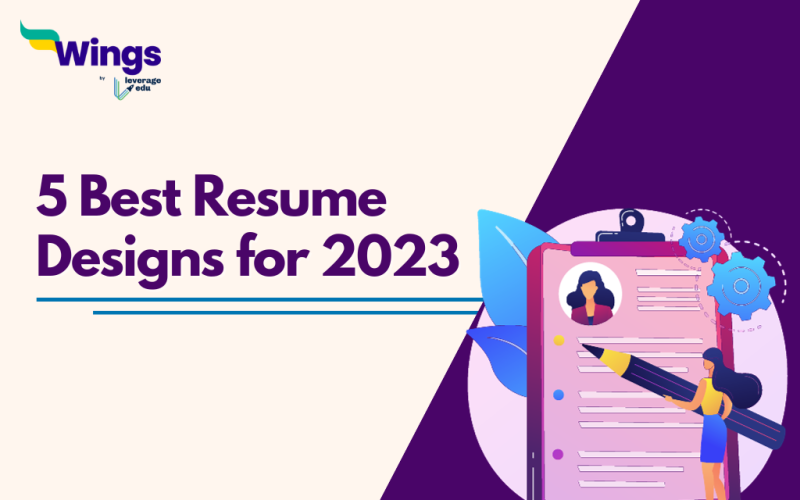A well-designed graphic resume showcases a graphic designer’s creativity, design expertise, and aesthetic sensibilities, according to Lensa. It not only highlights their ability to create impactful visual content but also highlights a highly sought-after skill set in the design industry. Yet, the importance of a well-designed resume isn’t limited to graphic designers alone. It holds significant value for professionals across diverse fields. A visually appealing and well-organized resume allows you to effectively convey your qualifications, accomplishments, and experiences, increasing your chances of getting shortlisted. To help you get started, we’ve got 5 best resume designs. Along with that, you will find some useful tips and tricks to create the best resume designs in 2024.
This Blog Includes:
Also Read: Resume vs Cover Letter: What is the Difference?
What Should a Resume Include?
A well-crafted resume should include essential information about your professional background, skills, and qualifications. Here’s what you should include in your resume to get shortlisted:
- Contact Information: This section should feature your full name, phone number, professional email address, and, optionally, your LinkedIn profile or personal website.
- Objective Statement: A concise statement summarising your career goals, skills, and what you can bring to the role you’re applying for.
- Professional Experience: This details your work history in reverse chronological order. Include the name of the company, your job title, dates of employment, and a bulleted list of key responsibilities and accomplishments.
- Education: List your educational institutions, degrees, and graduation dates. Include any relevant certifications or coursework.
- Skills: List the technical, soft, and language skills that are relevant to the position. This could contain software proficiency, language fluency, or leadership abilities.
- Achievements and Awards: Highlight any notable accomplishments or recognition you’ve received in your professional journey.
- Optional Sections: Depending on your field, you might add sections like Projects, Publications, or Volunteer Work to showcase additional relevant experiences.
Also Read: Area of Interest in Resume: What to Include and How?
5 Winning Resume Designs
Here are five winning resume design ideas along with the templates :
Clean and Minimalistic Design
Use a simple, sans-serif font for headings and a clean, easy-to-read font for body text. Incorporate subtle colour accents for section headers. Ensure ample white space for a polished look.
Infographic-Style Resume
Use visually appealing icons or graphics to represent skills, expertise and achievements. Arrange information in a visually engaging format, making it easy for the reader to scan and understand your key strengths.
Also Read: How to Prepare Graphic Designer Resume: Samples and Tips
Creative Visual Elements
Incorporate a unique header with a personal logo or monogram. Use custom-made icons or illustrations to represent different sections. Add a splash of colour to make your resume visually distinctive.
Timeline-Based Design
Create a timeline of your work experience, education, and key achievements. Use arrows or lines to indicate progression. This format provides a clear, chronological overview of your professional journey.
Two-Column Layout
Divide the page into two columns. Place your name, contact information, and a brief summary in one column. Use the second column for sections like professional experience, skills, and education. This layout provides an organized and balanced look.
5 Tips to Create the Best Resume Designs
Creating an outstanding resume design is important in making a positive first impression. Here are five key tips to ensure your resume stands out:
- Keep it Simple: Keep the design clean and orderly. Use a simple, professional font and maintain consistent formatting. Ensure that headings, subheadings, and body text are easy to read. Avoid using excessive graphics or overly elaborate fonts, as they can distract from the content.
- Maintain Visual Hierarchy: Arrange information logically, with the most important details prominently displayed. Use headings and subheadings to create a clear visual hierarchy. Your name and contact information should be prominent at the top, followed by sections like Objective, Professional Experience, Education, and Skills, in a logical order.
- Incorporate Visual Elements: Utilize design elements like lines, icons, or subtle colour accents to enhance the visual appeal. However, ensure they complement the overall aesthetic rather than overshadowing the content.
- Customize Accordingly: Try to customize the design to suit your industry or profession. For example, a creative field like graphic design or UI/UX Design might allow for more artistic elements, while a corporate setting may require a more conservative approach. Research industry norms and incorporate them into your design choices.
- Stay Consistent: Ensure that your resume looks consistent and professional both in print and digital formats. Test how it appears when printed and make adjustments if necessary. Also, save your resume in a universally compatible format like PDF to maintain its formatting across different devices and platforms.
Check out these Top 11 Skills to Put on a Resume
FAQs
Ans: A resume is a document that job applicants use to summarize their work experience, educational background, and special skills.
Ans: You must include objectives, experience, education, skills, projects, references, and awards in your resume.
Ans: A brief objective statement shows your career goals, skills, and what you can bring to the role you’re applying for.
Related Blogs:
Thank you for reading! For more interesting and useful content like this, Follow our page career counselling, and stay updated with Leverage Edu.
 One app for all your study abroad needs
One app for all your study abroad needs















 60,000+ students trusted us with their dreams. Take the first step today!
60,000+ students trusted us with their dreams. Take the first step today!

